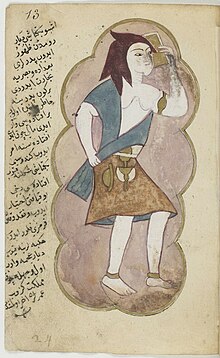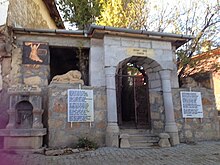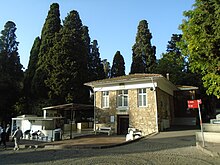
A | B | C | D | E | F | G | H | CH | I | J | K | L | M | N | O | P | Q | R | S | T | U | V | W | X | Y | Z | 0 | 1 | 2 | 3 | 4 | 5 | 6 | 7 | 8 | 9
| Alevism | |
|---|---|
| Alevilik | |
 | |
| Scripture | Quran, Nahj al-Balagha, Makalat and Buyruks |
| Leader | Dede |
| Teachings of | [8] |
| Theology | Haqq–Muhammad–Ali |
| Region | Turkey |
| Language | Turkish, Albanian, Azerbaijani, Kurdish, and Zazaki[9] |
| Liturgy | Cem, Sema |
| Headquarters | Haji Bektash Veli Complex, Nevşehir, Turkey |
| Founder | Haji Bektash Veli |
| Origin | 13th-century Sulucakarahöyük |
| Separated from | Sunni and Usuli Twelver theology |
| Other name(s) | Kızılbaşlık |
| Part of a series on Nizari-Ismāʿīli Batiniyya, Hurufiyya, Kaysanites and Twelver Shī‘ism |
|---|
|
|

Alevism, Anatolian Alevism or Qizilbashism[10] (/æˈlɛvɪzəm/; Turkish: Alevilik, Anadolu Aleviliği or Kızılbaşlık; Kurdish: Elewîtî, Rêya Heqî;[11][12][13] Azerbaijani: Ələvilik, Qızılbaşlıq) is a heterodox[14] and syncretic[15] Islamic tradition, whose adherents follow the mystical Islamic teachings of Haji Bektash Veli, who is supposed to have taught the teachings of the Twelve Imams whilst incorporating some traditions from Turkish Shamanism.[16] Differing from Sunni Islam and Usuli Twelver Shia Islam, Alevis have no binding religious dogmas, and teachings are passed on by a spiritual leader as with Sufi orders.[17] They acknowledge the six articles of faith of Islam, but may differ regarding their interpretation.[9]
Originally one of many Sufi approaches within Sunni Islam; by the 16th century the order adopted some tenets of the Shia Islam, including a veneration of ʿAlī and the twelve imams, as well as a variety of syncretic beliefs. The Alevis acquired political importance in the 15th century, when the order dominated the Janissaries.[18]
The term “Alevi-Bektashi” is currently a widely and frequently used expression in the religious discourse of Turkey as an umbrella term for the two religious groups of Alevism and Bektashism.[19] Adherents of Alevism are found primarily in Turkey and estimates of the percentage of Turkey's population that are Alevi include between 4% and 25%.[9][20][21]
Etymology
"Alevi" (/æˈlɛvi/) is generally explained as referring to Ali, the cousin and son-in-law of Muhammad. The name represents a Turkish form of the word ʻAlawiyy (Arabic: علوي) "of or pertaining to Ali".
A minority viewpoint is that of the Ishikists, who assert, "Alevi" was derived from "Alev" ("flame" in Turkish) in reference to fire which is extensively used in Alevi rituals. According to them the use of candles is based on Quran, surah an-Nur, verses 35–36:
God is the Light of the heavens and the earth. The example of His light is like a niche within which there is a lamp, the lamp is encased in a glass, the glass is like a radiant planet, which is lit from a blessed olive tree that is neither of the east nor of the west, its oil nearly gives off light even if not touched by fire. Light upon light, God guides to His light whom He pleases. And God sets forth examples for the people, and God is aware of all things. (Lit is such a Light) in houses, which God has permitted to be raised to honor; for the celebration, in them, of His name: In them is He glorified in the mornings and in the evenings, (again and again).
Beliefs
According to scholar Soner Çağaptay, Alevism is a "relatively unstructured interpretation of Islam".[22] Journalist Patrick Kingsley states that for some self-described Alevi, their religion is "simply a cultural identity, rather than a form of worship".[14]
Many teachings are based on an orally transmitted tradition, traditionally kept secret from outsiders (but now widely accessible). Alevis commonly profess the Islamic shahada, but adding "Ali is the friend of God".
The basis for Alevis' most distinctive beliefs is found in the Buyruks (compiled writings and dialogues of Sheikh Safi-ad-din Ardabili, and other worthies). Also included are hymns (nefes) by figures such as Shah Ismail or Pir Sultan Abdal, stories of Hajji Bektash and other lore.
The Alevi beliefs among Turkish Alevis and Kurdish Alevis diverge as Kurdish Alevis put more emphasis on Pir Sultan Abdal than Haji Bektash Veli, and Kurdish Alevism is rooted more in nature veneration.[23][24]
God
In Alevi cosmology, God is also called Al-Haqq (the Truth)[25] or referred to as Allah. God created life, so the created world can reflect His Being.[26] Alevis believe in the unity of Allah, Muhammad, and Ali, but this is not a trinity composed of God and the historical figures of Muhammad and Ali. Rather, Muhammad and Ali are representations of Allah's light (and not of Allah himself), being neither independent from God, nor separate characteristics of Him.[25]
In Alevi writings are many references to the unity of Muhammad and Ali, such as:

Ali Muhammed'dir uh dur fah'ad, Muhammad Ali, ("Ali is Muhammad, Muhammad is Ali") Gördüm bir elmadır, el-Hamdû'liLlâh. ("I've seen an apple, all praise is for God")[27]
The phrase "For the love of Haqq–Muhammad–Ali" (Hakk–Muhammad–Ali aşkına) is common to several Alevi prayers.
Spirits and afterlife
Alevis believe in the immortality of the soul,[25] the literal existence of supernatural beings, including good angels (melekler) and bad angels (şeytanlar),[28] bad ones as encourager of human's evil desires (nefs), and jinn (cinler), as well as the evil eye.[29]
Angels feature in Alevi cosmogony. Although there is no fixed creation narrative among Alevis, it is generally accepted that God created five archangels, who have been invited to the chamber of God. Inside they found a light representing the light of Muhammad and Ali. A recount of the Quranic story, one of the archangels refused to prostrate before the light, arguing, that the light is a created body just like him and therefore inappropriate to worship. He remains at God's service, but rejects the final test and turns back to darkness. From this primordial decline, the devil's enmity towards Adam emerged. (The archangels constitute of the same four archangels as within orthodox Islam. The fifth archangel namely Azazil fell from grace, thus not included among the canonical archangels apart from this story).[30]
Another story features the archangel Gabriel (Cebrail), who is asked by God, who they are. Gabriel answers: "I am I and you are you". Gabriel gets punished for his haughty answer and is sent away, until Ali reveals a secret to him. When God asks him again, he answers: "You are the creator and I am your creation". Afterwards, Gabriel was accepted and introduced to Muhammad and Ali.[30]
Scriptures and prophets
Alevis acknowledge the four revealed scriptures also recognized in Islam: the Tawrat (Torah), the Zabur (Psalms), the Injil (Gospel), and the Quran.[31] Additionally, Alevis are not opposed to looking to other religious books outside the four major ones as sources for their beliefs including Hadiths, Nahjul Balagha and Buyruks. Alevism also acknowledges the Islamic prophet Mohammed. Unlike the vast majority of Muslims, Alevis do not regard interpretations of the Quran today as binding or infallible, since the true meaning the Quran is considered to be taken as a secret by Ali and must be taught by a teacher, who transmits the teachings of Ali (Buyruk) to his disciple.[32]
Twelve Imams
The Twelve Imams are part of another common Alevi belief. Each Imam represents a different aspect of the world. They are realized as twelve services or On İki Hizmet which are performed by members of the Alevi community. Each Imam is believed to be a reflection of Ali ibn Abu Talib, the first Imam of the Shi'ites, and there are references to the "First Ali" (Birinci Ali), Imam Hasan the "Second 'Ali" (İkinci Ali), and so on up to the "Twelfth 'Ali" (Onikinci Ali), Imam Mehdi. The Twelfth Imam is hidden and represents the Messianic Age.
Plurality
The plurality in nature is attributed to the infinite potential energy of Kull-i Nafs when it takes corporeal form as it descends into being from Allah. During the Cem ceremony, the cantor or aşık sings:
- "All of us alive or lifeless are from one, this is ineffable, Sultan.
- For to love and to fall in love has been my fate from time immemorial."
This is sung as a reminder that the reason for creation is love, so that the followers may know themselves and each other and that they may love that which they know.
Perfect human being

Linked to the concept of the Prototypical Human is that of the al-Insān al-Kāmil "Perfect Human Being". Although it is common to refer to Ali and Haji Bektash Veli or the other Alevi saints as manifestations of the perfect human being, the Perfect Human Being is also identified with our true identity as pure consciousness, hence the Qur'anic concept of human beings not having original sin, consciousness being pure and perfect. [citation needed] The human task is to fully realize this state while still in material human form.
The perfect human being is also defined in practical terms, as one who is in full moral control of his or her hands, tongue and loins (eline diline beline sahip); treats all kinds of people equally (yetmiş iki millete aynı gözle bakar); and serves the interests of others. One who has achieved this kind of enlightenment is also called eren or münevver "enlightened".[citation needed]
Creed and jurisprudence

Sources differ on how important formal doctrine is among contemporary Alevi. According to scholar Russell Powell, there is a tradition of informal "Dede" courts within the Alevi society, but regarding Islamic jurisprudence or fiqh there has been "little scholarship on Alevi influences" in it.[35]
- "The Alevi-Turks" has a unique belief system tracing back to Kaysanites and Khurramites, which are considered ghulat Shi'ism. According to Turkish scholar Abdülbaki Gölpinarli, the Qizilbash "Red Heads" of the 16th century, a religious and political movement in Azerbaijan that helped to establish the Safavid dynasty, were spiritual descendants of the Khurramites.[36]
- Among the members of the Qizilbash order, who are a subsect of the Alevis, Abu Muslim (who assisted Abbasid Caliphate to beat the Umayyad Caliphate, but who was later eliminated and murdered by Caliph al-Mansur) and Babak Khorramdin (who incited a rebellion against Abbasid Caliphate and consequently was killed by Caliph al-Mu'tasim) are highly respected. This belief provides strong clues about Kaysanite and Khurramite origins. In addition, Safavid order leader Ismail I is a highly regarded individual in Alevism associating them with the theology of Twelver Shia Islam.[citation needed]
Practices
The Alevi spiritual path (yol) is commonly understood to take place through four major life-stages, or "gates". These may be further subdivided into "four gates, forty levels" (Dört Kapı Kırk Makam). The first gate (religious law) is considered elementary (and this may be perceived as subtle criticism of other Muslim traditions).
The following are major crimes that cause an Alevi to be declared düşkün (shunned):[37]
- killing a person
- committing adultery
- divorcing one's wife without a just reason
- stealing
- backbiting/gossiping
Most Alevi activity takes place in the context of the second gate (spiritual brotherhood), during which one submits to a living spiritual guide (dede, pir, mürşid). The existence of the third and fourth gates is mostly theoretical, though some older Alevis have apparently received initiation into the third.[38]
Rakia, a fruit brandy, is used as a sacramental element by the Bektashi Order,[39] and Alevi Jem ceremonies, where it is not considered alcoholic and is referred to as "dem".[40]
Dede
A Dede (literally meaning grandfather) is a traditional leader that is claimed to be from the lineage of Muhammad that performs ritual baptisms for newborns, officiates at funerals, and organises weekly gatherings at cemevis.[41]
Cem and Cemevi


Alevi religious, cultural and other social activities take place in assembly houses (Cemevi). The ceremony's prototype is the Muhammad's nocturnal ascent into heaven, where he beheld a gathering of forty saints (Kırklar Meclisi), and the Divine Reality made manifest in their leader, Ali.
The Cem ceremony features music, singing, and dancing (Samāh) in which both women and men participate. Rituals are performed in Turkish, Zazaki, Kurmanji and other local languages.
- Bağlama
During the Cem ceremony the Âşık plays the Bağlama whilst singing spiritual songs, some of which are centuries old and well known amongst Alevis. Every song, called a Nefes, has spiritual meaning and aims to teach the participants important lessons.
- Samāh
A family of ritual dances characterized by turning and swirling, is an inseparable part of any cem. Samāh is performed by men and women together, to the accompaniment of the Bağlama. The dances symbolize (for example) the revolution of the planets around the Sun (by man and woman turning in circles), and the putting off of one's self and uniting with God.
- Görgü Cemi
The Rite of Integration (görgü cemi) is a complex ritual occasion in which a variety of tasks are allotted to incumbents bound together by extrafamilial brotherhood (müsahiplik), who undertake a dramatization of unity and integration under the direction of the spiritual leader (dede).
- Dem
The love of the creator for the created and vice versa is symbolised in the Cem ceremony by the use of fruit juice and/or red wine[citation needed] which represents the intoxication of the lover in the beloved. During the ceremony Dem is one of the twelve duties of the participants. (see above)
- Sohbet
At the closing of the cem ceremony the Dede who leads the ceremony engages the participants in a discussion (chat), this discussion is called a sohbet.
Twelve services
There are twelve services (Turkish: On İki hizmet) performed by the twelve ministers of the cem.
- Dede: This is the leader of the Cem who represents Muhammad and Ali. The Dede receives confession from the attendees at the beginning of the ceremony. He also leads funerals, Müsahiplik, marriage ceremonies and circumcisions. The status of Dede is hereditary and he must be a descendant of Ali and Fatima.
- Rehber: This position represents Husayn. The Rehber is a guide to the faithful and works closely with the Dede in the community.
- Gözcü: This position represents Abu Dharr al-Ghifari. S/he is the assistant to the Rehber. S/he is the Cem keeper responsible for keeping the faithful calm.
- Çerağcı: This position represents Jabir ibn Abd-Allah and s/he is the light-keeper responsible for maintaining the light traditionally given by a lamp or candles.
- Zakir: This position represents Bilal ibn al-Harith. S/he plays the bağlama and recites songs and prayers.
- Süpürgeci: This position represents Salman the Persian. S/he is responsible for cleaning the Cemevi hall and symbolically sweeping the carpets during the Cem.
- Meydancı: This position represents Hudhayfah ibn al-Yaman.
- Niyazcı: this position represents Muhammad ibn Maslamah. S/he is responsible for distributing the sacred meal.
- İbrikçi: this position represents Kamber. S/he is responsible for washing the hands of the attendees.
- Kapıcı: this position represents Ghulam Kaysan. S/he is responsible for calling the faithful to the Cem.
- Peyikçi: this position represents Amri Ayyari.
- Sakacı: represents Ammar ibn Yasir. Responsible for the distribution of water, sherbet (sharbat), milk etc..
Festivals

Alevis celebrate and commemorate the birth of Ali, his wedding with Fatima, the rescue of Yusuf from the well, and the creation of the world on this day. Various cem ceremonies and special programs are held.
Mourning of Muharram
The Muslim month of Muharram begins 20 days after Eid ul-Adha (Kurban Bayramı). Alevis observe a fast for the first twelve days, known as the Mourning of Muharram (Turkish: Muharrem Mâtemi, Yâs-ı Muharrem, or Mâtem Orucu; Kurdish: Rojîya Şînê or Rojîya Miherremê). This culminates in the festival of Ashura (Aşure), which commemorates the martyrdom of Husayn at Karbala. The fast is broken with a special dish (also called aşure) prepared from a variety (often twelve) of fruits, nuts, and grains. Many events are associated with this celebration, including the salvation of Husayn's son Ali ibn Husayn from the massacre at Karbala, thus allowing the bloodline of the family of Muhammad to continue.
Hıdırellez

Hıdırellez honors the mysterious figure Khidr (Turkish: Hızır) who is sometimes identified with Elijah (Ilyas), and is said to have drunk of the water of life. Some hold that Khidr comes to the rescue of those in distress on land, while Elijah helps those at sea; and that they meet at a rose tree in the evening of every 6 May. The festival is also celebrated in parts of the Balkans by the name of "Erdelez," where it falls on the same day as George's Day in Spring or Saint George's Day.
Khidr is also honored with a three-day fast in mid-February called Hızır Orucu. In addition to avoiding any sort of comfort or enjoyment, Alevis also abstain from food and water for the entire day, though they do drink liquids other than water during the evening.
Note that the dates of the Khidr holidays can differ among Alevis, most of whom use a lunar calendar, but some a solar calendar.
Müsahiplik
Müsahiplik (roughly, "Companionship") is a covenant relationship between two men of the same age, preferably along with their wives. In a ceremony in the presence of a dede the partners make a lifelong commitment to care for the spiritual, emotional, and physical needs of each other and their children. The ties between couples who have made this commitment is at least as strong as it is for blood relatives, so much so that müsahiplik is often called spiritual brotherhood (manevi kardeşlik). The children of covenanted couples may not marry.[42]
Krisztina Kehl-Bodrogi reports that the Tahtacı identify müsahiplik with the first gate (şeriat), since they regard it as a precondition for the second (tarikat). Those who attain to the third gate (marifat, "gnosis") must have been in a müsahiplik relationship for at least twelve years. Entry into the third gate dissolves the müsahiplik relationship (which otherwise persists unto death), in a ceremony called Öz Verme Âyini ("ceremony of giving up the self").
The value corresponding to the second gate (and necessary to enter the third) is âşinalık ("intimacy," perhaps with God). Its counterpart for the third gate is called peşinelik; for the fourth gate (hâkikat, Ultimate Truth), cıngıldaşlık or cengildeşlik (translations uncertain).[43]
Folk practices
Many folk practices may be identified, though few of them are specific to the Alevis. In this connection, scholar Martin van Bruinessen notes a sign from Turkey's Ministry of Religion, attached to Istanbul's shrine of Eyüp Sultan, which presents
...a long list of ‘superstitious’ practices that are emphatically declared to be non-Islamic and objectionable, such as lighting candles or placing ‘wishing stones’ on the tomb, tying pieces of cloth to the shrine or to the trees in front of it, throwing money on the tomb, asking the dead directly for help, circling seven times around the trees in the courtyard or pressing one’s face against the walls of the türbe in the hope of a supernatural cure, tying beads to the shrine and expecting supernatural support from them, sacrificing roosters or turkeys as a vow to the shrine. The list is probably an inventory of common local practices the authorities wish to prevent from re-emerging.[44]
Other, similar practices include kissing door frames of holy rooms; not stepping on the threshold of holy buildings; seeking prayers from reputed healers; and making lokma and sharing it with others. Also, Ashure is made and shared with friends and family during the month of Muharram in which the Day of Ashure takes place.[45]
Ziyarat to sacred places
Performing ziyarat and du'a at the tombs of Alevi-Bektashi saints or pirs is quite common. Some of the most frequently visited sites are the shrines of Şahkulu and Karacaahmet (both in Istanbul), Abdal Musa (Antalya), Seyyid Battal Gazi Complex (Eskişehir), Hamza Baba (İzmir), Hasandede (Kırıkkale).[46]
In contrast with the traditional secrecy of the Cem ceremony ritual, the events at these cultural centers and sites are open to the public. In the case of the Hacibektaş celebration, since 1990 the activities there have been taken over by Turkey's Ministry of Culture in the interest of promoting tourism and Turkish patriotism rather than Alevi spirituality. The annual celebrations held at Hacıbektaş (16 August) and Sivas (the Pir Sultan Abdal Kültür Etkinlikleri, 23–24 June).
Some Alevis make pilgrimages to mountains and other natural sites believed to be imbued with holiness.
Almsgiving
Alevis are expected to give zakat, but there is no set formula or prescribed amount for annual charitable donation as there is in other forms of Islam (2.5% of possessions above a certain minimum). Rather, they are expected to give the "excess" according to Qur'an 2:219. A common method of Alevi almsgiving is through donating food (especially sacrificial animals) to be shared with worshippers and guests. Alevis also donate money to be used to help the poor, to support the religious, educational and cultural activities of Alevi centers and organizations (dargahs, awqaf, and meetings), and to provide scholarships for students.
History

Seljuk period
During the great Turkish expansion from Central Asia into Iran and Anatolia in the Seljuk period (11–12th centuries), Turkmen and Kurdish nomad tribes accepted a Sufi and pro-Ali form of Islam that co-existed with some of their pre-Islamic customs. Their conversion to Islam in this period was achieved largely through the efforts not of textual scholars (ulema) expounding the finer points of Koranic exegesis and shari‘a law, but by charismatic Sufi dervishes a belief whose cult of Muslim saint worship, mystical divination and millenarianism spoke more directly to the steppe mindset. These tribes dominated Anatolia for centuries with their religious warriors (ghazi) spearheading the drive against Byzantines and Crusaders.[47][page needed][verification needed]
Ottoman periodedit
As in Khorasan and West Asia before, the Turkmens who spearheaded the Ottomans’ drive into the Balkans and West Asia were more inspired by a vaguely Shiite folk Islam than by formal religion. Many times, Ottoman campaigns were accompanied or guided by Bektaşi dervishes, spiritual heirs of the 13th century Sufi saint Haji Bektash Veli, himself a native of Khorasan. After the conquest of Constantinople in 1453, the Ottoman state became increasingly determined to assert its fiscal but also its juridical and political control over the farthest reaches of the Empire.[47]
The resulting Qizilbash revolts, a series of millenarian anti-state uprisings by the heterodox Turkmen population of Anatolia that culminated in the establishment of a militantly Shiite rival state in neighbouring Iran.[47] The Ottoman Empire later proclaimed themselves its defenders against the Safavid Shia state and related sects. This created a gap between the Sunni Ottoman ruling elite and the Alevi Anatolian population. Anatolia became a battlefield between Safavids and Ottomans, each determined to include it in their empire.
Republic of Turkeyedit
According to Eren Sarı, Alevi saw Kemal Atatürk as a Mahdi "savior sent to save them from the Sunni Ottoman yoke".[48] However, pogroms against Alevi did not cease after the establishment of Atatürk's republic. In attacks against leftists in the 1970s, ultranationalists and reactionaries killed many Alevis. Malatya in 1978, Maraş in 1979, and Çorum in 1980 witnessed the murder of hundreds of Alevis, the torching of hundreds of homes, and lootings.[49][50]
Alevis have been victims of pogroms during both Ottoman times and under the Turkish republic up until the 1993 Sivas massacre.[14][49][50]




